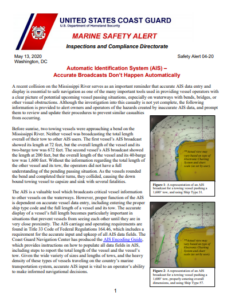The Inspections and Compliance Directorate reminds the maritime community that accurate AIS data entry and display is essential to safe navigation.
A recent collision on the Mississippi River serves as an important reminder that accurate AIS data entry and display is crucial to safe navigation. This is considered an important tool, which provides vessel operators with a clear picture of possible upcoming vessel passing situations.
Regarding this incident, prior to sunrise, two towing vessels were approaching a bend on the Mississippi River. Neither vessel was broadcasting the total length overall of their tow to other AIS users. The first vessel’s AIS broadcast showed its length at 72 feet, but the total length of the ship and its two-barge tow was 672 feet. The second vessel’s AIS broadcast showed the length at 200 feet, but the overall length of the vessel and its 40-barge tow was 1,600 feet.
Without the information regarding the total length of the other vessel and its tow, the operators did not have a full understanding of the pending passing situation. As the ships rounded the bend and completed their turns, they collided, causing the down bound towing vessel to capsize and sink with several fatalities.
The AIS is a valuable tool that broadcasts critical vessel information to other vessels on the waterways. However, the proper function of the AIS depends on accurate vessel data entry, including entering the proper ship type code and the full length of a vessel and its tow.
The accurate display of a vessel’s full length becomes particularly important in situations that prevent vessels from seeing each other until they are in very close proximity.
The AIS carriage and operating requirements are found in Title 33 Code of Federal Regulations 164.46, which includes a requirement for the accurate input and upkeep of all AIS data fields.
The US Coast Guard Navigation Center has produced the AIS Encoding Guide, providing instructions on how to populate all data fields in AIS, including steps to report the total length of the vessel and the vessel’s tow.
Considering the wide variety of sizes and lengths of tows, and the heavy density of these types of vessels traveling on the US’s marine transportation system, accurate AIS input is vital to an operator’s ability to make informed navigational decisions.
The US Coast Guard strongly recommends that vessel Owners and Operators:
- Use the AIS Encoding Guide to ensure that accurate and up to date information is entered into the AIS, including, but not limited to, the overall dimensions of the vessel and its tow.
- For vessels towing ahead or alongside, use Ship Type 57 (not Ship Type 31) within the static data fields in order to broadcast the overall dimensions of the vessel and its tow.
- Ensure towing vessel personnel responsible for navigational duties have the appropriate training and resources in order to update AIS data when tow sizes change.
- Investigations and inspection personnel are encouraged to maintain an acute awareness of AIS data issues while investigating marine casualties and initiate corrective actions as needed.































































